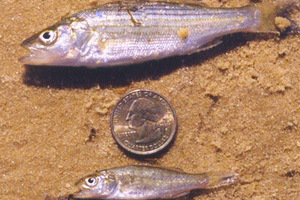The largest striped bass ever recorded, a female, weighed 56.8 kg (125 lb) and was taken in a net off North Carolina in 1891.
Photo Credit: Maryland DNR
Morone saxatilis
Common Name: striped bass
Other Common Names: striper
Other Scientific Names: Roccus saxitilis
Animal Guild: Fish
Class > Order > Family: Teleostei > Perciformes > Moronidae
